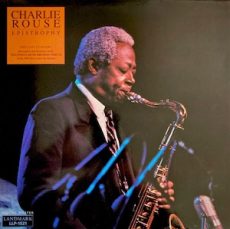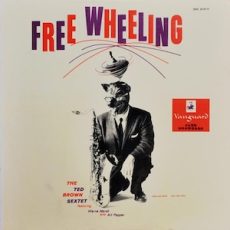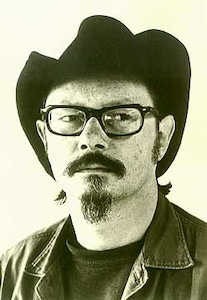
Jazz Poems
JAZZ I’d like to know everything A jazz artist knows, starting with the song “Goodbye Pork Pie Hat.” Like to make some songs myself “Goodbye Rickshaw,” “Goodbye Lemondrop,” “Goodbye Rendezvous.” Or maybe even blues: If you fall in love with me I’ll make you pancakes All morning. If you fall in love with me I’ll make you pancakes all night. If you don’t like pancakes We’ll go to the creperie. If you don’t like pancakes We’ll go to the creperie. If you don’t like to eat, handsome boy, Don’t you hang around with me. On second thought, i’d rather find The fanciest music I can, and hear all of it. I’d rather love somebody And say his name to myself every day Until I fall apart. ANGELA BALLfrom Jazz Poems ~ Selected and Edited by Kevin Young
More Posts: book,classic,collectible,history,jazz,library,poet

Requisites
Epistrophy: The Last Concert ~ Charlie Rouse | By Eddie Carter
Charlie Rouse was one of jazz’s great musicians, but he is best known as the tenor saxophonist in The Thelonious Monk Quartet for eleven years. He enters this morning’s spotlight with Epistrophy–The Last Concert (Landmark Records LLP-1521). The album honors the pianist and was recorded live at The Thelonious Monk Birthday Tribute during the Jazz in The City Festival. His bandmates for this exceptional performance are Don Cherry (tracks: B1, B2) on trumpet, Buddy Montgomery (B1, B2) on vibes, George Cables (A2, A3, B1, B2), and Jessica Williams (A4) on piano, Jeff Chambers on bass, and Ralph Penland on drums. Orrin Keepnews is the host. My copy is the 1989 U.S. Stereo release.
Orrin opens with a few words about Charlie Rouse before introducing him; then, the two men share Some Words About Monk that are just as entertaining as the music that follows. Nutty is taken at a medium tempo, and Charlie swings easily on the theme and the first solo. George picks up the groove and gets into something interesting; then Ralph shares the finale with Rouse and Cables preceding the ending. Ruby, My Dear is named after Monk’s first love, Rubie Richardson and is one of his most beautiful tunes. Charlie and the trio tenderly begin the melody. Rouse continues delivering the opening solo with sultry notes from his tenor sax. George compliments him with elegant execution in a short statement. Charlie adds a few final gentle touches before the closing chorus and the delight of the crowd.
Blue Monk was Monk’s personal favorite of all his compositions. Jessica takes over on piano and opens with a quirky introduction to the foursome’s bluesy melody. Charlie takes the lead solo with a relaxing informality that flows naturally. Jessica takes a comfortable ride in the second reading, and Jeff has an enjoyable moment in the closer, preceding the theme’s restatement and close. ‘Round Midnight by Thelonious Monk, Cootie Williams and Bernie Hanighen is Monk’s best-known and most recorded creation. George starts with a lengthy introduction, segueing into the trio’s gorgeous melody and the pianist’s opening solo. Buddy comes in next for a touching interpretation, and then Don expresses his thoughts in a haunting, muted performance. Charlie provides the pretty exclamation point ahead of the climax.
Epistrophy by Thelonious Monk and Kenny Clarke was the pianist’s closing number at each live set. George sets everything in motion for the ensemble’s lively melody. Don opens with a few twists and turns; then Charlie wails with ease next. Buddy answers with a spirited performance. George adds to the excitement, and Don, Charlie, and Buddy swap notes with Ralph ahead of the reprise and close, which receives abundant applause from the audience. Orrin Keepnews produced the album, and Ron Davis was the recording engineer. David Luke was the digital engineer, and the mastering was by George Horn. The album’s sound quality is stunning with an excellent soundstage that takes the listener to the club to enjoy the musicians as they are performing.
Epistrophy-The Last Concert is dedicated to Charlie Rouse’s memory and is the last album he recorded before his death from lung cancer seven weeks later on November 30, 1988. He was only sixty-four but leaves behind a legacy of thirteen albums as a leader. He also co-founded and recorded six albums with the group Sphere (Thelonious’ middle name). He also made quite a few titles as a sideman, including twenty-four with Thelonious Monk during his lifetime. Palo Alto was recorded in 1968 but not released until 2020. If you’re a fan of Monk’s music or Post Bop, I offer for your consideration, Epistrophy–The Last Concert by Charlie Rouse the next time you visit your favorite record shop. It’s one of the most enjoyable albums I’ve heard and is a title I’m sure you won’t regret adding to your library!
~ Palo Alto (Impulse B0032181-01) – Source: Discogs.com ~ Blue Monk, ‘Round Midnight – Source:JazzStandards.com ~ Epistrophy, Ruby, My Dear – Source: Wikipedia.org © 2024 by Edward Thomas Carter***In Like Bud which is included in the YouTube version of the album, is only available on compact disc and not on the original wax recording.
More Posts: choice,classic,collectible,collector,history,instrumental,jazz,music,saxophone

Jazz Poems
FALL DOWN in memory of eric dolphy All men are locked in their cells. Though we quake In fist of body Keys rattle, set us free. I remember and wonder why? In fall, in summer; times Will be no more. Journeys End. I remember and wonder why? In the sacred labor of lung Spine and groin, You cease, fly away To what? To autumn, to Winter, to brown leaves, to Wind where no lark sings; yet Through dominion of air, jaw and fire I remember! Eric Dolphy, you swung A beautiful axe. You lived a clean Life. You were young– You died. Calvin Herntonfrom Jazz Poems ~ Selected and Edited by Kevin Young
More Posts: book,classic,collectible,history,jazz,library,poet

Requisites
Free Wheeling ~ The Ted Brown Sextet Featuring Warne Marsh and Art Pepper | By Eddie Carter
I first heard a track from Free Wheeling (Vanguard VRS-8515) by The Ted Brown Sextet a few years ago on Sirius XM’s Real Jazz. I’ve loved the tenor sax since I was a child, so I was ecstatic to discover a new musician and finally get a copy. It was Ted’s first release as a leader, and the music within it is an excellent representation of West Coast jazz. During his career, he recorded with Lee Konitz, Hod O’ Brien, and Lennie Tristano, and on this date, he’s joined by Art Pepper on alto sax, Warne Marsh on tenor sax, Ronnie Ball on piano, Ben Tucker on bass, and Jeff Morton on drums. My copy is the 1975 King Record Company Japanese Mono reissue (Vanguard GXC 3121M).
Side one starts with the front line’s brisk introduction to Aretha by Ronnie Ball. Ronnie infuses the first solo with energy and agility. Art and Warne follow in successive order, hitting an ideal groove. Jeff is up next with a brief but lively finale ahead of the sextet’s theme’s restatement and climax. The ensemble moves the needle upward for Long Gone by Warne Marsh. The front line sets the mood in the opening chorus; then, Ted makes his entrance first for an exciting solo. Warne steps up next and takes the reins. Ronnie follows with a swift reading; then Art gets right to work and cooks. Jeff signals the end with a brief comment into the closing chorus and ending.
Once We Were Young by Walter Gross is a lovely song that Ted begins with a dreamy melody that Warne picks up in the background. Ronnie comes in for a short, sensitive interlude until both horns return for a beautiful theme restatement and tender climax. Foolin’ Myself is the creation of Andy Razaf and Thomas “Fats” Waller. The rhythm section starts with a mid-tempo introduction, segueing into the catchy melody. Ronnie takes the lead and gives an enchanting interpretation. Ted begins the second statement, then is joined by Art and Warne in succession for a hauntingly sincere reading that concludes softly.
The sextet takes us to Avalon by Al Jolson, Buddy DeSylva and Vincent Rose. The song’s title comes from a California city, and the front line kicks off the lively melody together. Ted goes first and makes a vigorous opening statement. Jeff succeeds him and delivers the goods in a spirited conversation with the leader before the group reconvenes to take the song out. On a Slow Boat To China by Frank Loesser starts Side Two with the sextet slowing the beat slightly for the opening chorus. Ted is thoroughly at ease in the first interpretation, and then Ronnie takes a few lovely choruses. Ted and Ronnie have a short exchange preceding the song’s conclusion.
Crazy She Calls Me by Carl Sigman and Bob Russell begins with the ensemble’s moving, deeply satisfying theme. Warne is the first soloist, and from his horn, notes of velvety softness flow. Ronnie expresses the song’s sentimentality next. Ted handles the following reading with a good deal of warmth, and then Warne returns to help bring the song to a gorgeous climax. Broadway by Wilbur H. Bird, Teddy McRae and Henri Woode opens with the front line’s collective melody. Warne, Art, and Ted are the first three in the solo spotlight, followed by an ensemble chorus together. Ronnie takes a splendid reading next, then Ben has a short summation as Jeff keeps perfect time toward the finale.
Arrival by Ronnie Ball is our final stop in this cool jazz session, and it’s off to the races from the start of the melody. Art leads the way with a swift opening statement. Warne delivers the second solo fleetingly; then, both horns make quick work of the finale in an exchange with Jeff before taking the song out. Alfred Marx supervised the original session, and the Vanguard Recording Society, Inc. recorded it. The sound quality of this reissue is exceptionally good and for a vintage fifties recording, exceeded my expectations. The music is also excellent, as is the pressing, and the vinyl is noticeably quiet.
There is one error on my copy, which doesn’t appear on the original album. The composers for Crazy She Calls Me are incorrectly listed on the Side Two label as the team of Cahn and Mayer but actually are Carl Sigman and Bob Russell. The album cover is also one of the strangest I’ve ever seen, but don’t let that dissuade you from checking out Free Wheeling by The Ted Brown Sextet on your next record hunt. If you’re a fan of cool jazz or West Coast Jazz, it’s a great-blowing session with Warne Marsh and Art Pepper and a wonderful introduction to a musician deserving of wider recognition. To borrow a quote from the great Vin Scully in game one of the 1988 World Series, “Not a bad opening act!”
~ Avalon – Source: JazzStandards.com ~ Broadway, Crazy She Calls Me, On a Slow Boat To China – Source: Wikipedia.org © 2024 by Edward Thomas Carter
More Posts: choice,classic,collectible,collector,history,instrumental,jazz,music,saxophone

Jazz Poems
LISTENING TO SONNY ROLLINS AT THE FIVE SPOT There will many other nights like this be standing here with someone, some one someone some-one some some some some some some one there will be other songs a-nother fall, another–spring, but there will never be a-noth, noth anoth noth anoth-er noth-er noth-er Other lips that I may kiss but they won’t thrill me like thrill me like like yours used to dream a million dreams but how can they come when there never be a-noth– Paul BlackburnFrom Jazz Poems | Selected and edited by Kevin Young
More Posts: book,classic,collectible,history,jazz,library,poet



